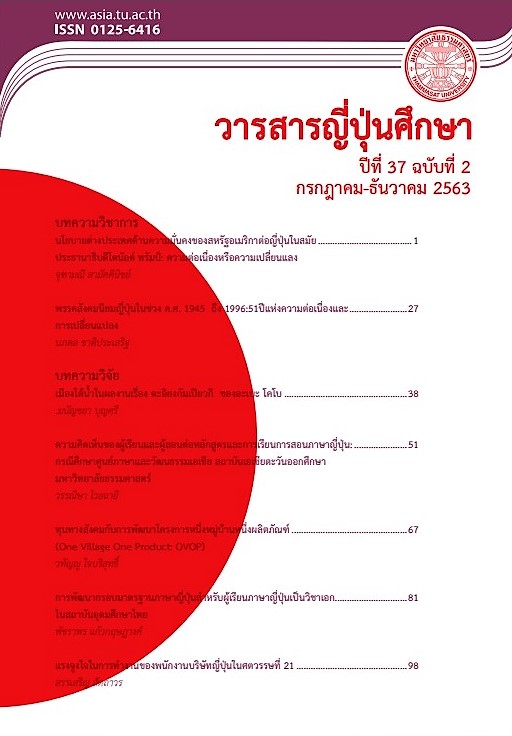Developing Japanese Language Standards for Students Majoring in Japanese at Thai Universities
Keywords:
Japanese Language Standards, Can-Do Statements, Japanese Language Education in ThailandAbstract
This study looks at the feasibility of applying Can-Do Statements-based Japanese language education to revise the current education, set Japanese language standards for students majoring in Japanese language at universities in Thailand. Since the appearance of the CEFR and JF Standard, Can-Do Statements-based education has been at the core of Japanese language education. This research found that most of universities in Thailand have not set a concrete standard for their curriculum. Japanese language standards for students majoring in Japanese at Thai universities are presented in this paper. It is a challenge. The current Japanese language curriculum must be revised to focus more on Can-Do Statements-based education. Accordingly, new textbooks and materials with this focus will need to be developed.
Downloads
References
Richards, J.C. and Schmidt, R.W. (eds.), Language and Communication, pp.2-27, New
York: Longman.
Chawengkijwanich, S., & Neancharoensuk, S. (2014). Japanese Grammar Teaching Methods: How
to teach Japanese grammar to Thai students. Bangkok: Thammasat University Press.
(in Thai)
Chirasombutti, V., & Kitamura, T. (1996). Japanese-Language Education in Thailand. Current
report on Japanese-language education around the globe, (4), 13-27. (in Japanese)
Council of Europe. (2001). Common European Framework of Reference for Languages: Leaning,
teaching, assessment. Cambridge: Cambridge University Press. Retrieved 20 May 2017,
from https://rm.coe.int/1680459f97
Hymes, D. (1972). On communicative competence. In Pride, J. and Holmes, J.(eds.),
Sociolinguistics: Selected Readings, pp.269-293, Harmondsworth: Penguin.
Iori, I. (2006). Japanese Language Proficiency Test: From the viewpoint of pedagogical grammar.
In Prof.Toki Satoshi 60 th. Birthday celebration committee. (Eds.), Japanese Language
Education to the world, pp. 61-70, Kuroshio Publishers. (in Japanese)
Japanese Language Center for International Students, Tokyo University of Foreign Studies.
(2011). JLC Japanese Standards 2011 Revision. Japanese Language Center for
International Students, Tokyo University of Foreign Studies. (in Japanese)
Jongsutjarittam, P. et al. (2004). Basic Japanese-Language Education in Thailand.The Japan
Foundation, Bangkok Journal, 1, 115-140. (in Thai)
Kaewkitsadang, P., & Srisattarat, S. (2010). A Study on Problems of Japanese Language
Education in High Schools and Higher Educational Institutes in Thailand. Research
Report submitted to Toshiba International Foundation.
Katagiri, K. et al. (2007). Setting basic Japanese grammar for Thai learners: 4 suggestions from the
viewpoint of pedagogical grammar. The Japan Foundation, Bangkok Journal, 4, 67-78. (in
Thai)
Katagiri, K. (2012). Japanese Language Standard for Speaking and Listening Skills for Students
with Japanese Majors in University: A Case Study of Chulalongkorn University. Journal of
Letters, 41(1), 1-35. (in Thai)
Nagai, N., & O’Dwyer, F. (2011). The actual and potential impacts of the CEFR on language
education in Japan. Synergies Europe, (6), 141-152. Retrieved 25 April 2016, from
https://gerflint.fr/Base/Europe6/noriko.pdf
Noda, H. et al. (2005). Acquisition of Grammar by Japanese Language Learners. Taishukan
Publishing. (in Japanese)
Office of the Higher Education Commission. (2016). Universities 2015. Retrieved 25 April 2016,
from http://www.mua.go.th/know_ohec/university_mua.xls (in Thai)
Sakamoto, M., & Oyama, R. (2014). Appling the “JLC Japanese Standards” to Practical Use in
an Educational Program- Through a Focus on Oral Expression-. Bulletin of Japanese
Language Center for International Students, 40, 69-86. (in Japanese)
Skulkru, P., & Kaewkitsadang, P. (2011). Japanese Graduates: Towards World-Class Standards.
Japanese Studies Journal, 27(2), 49-66. (in Thai)
Skulkru, P., & Kaewkitsadang, P. (2013). Analysis of Thammasat University’s Japanese Language
Curriculum and the Contents: Towards World-Class Standard. Journal of Japanese
language and culture, 1(1), 27-52. (in Thai)
Takamizawa, H. et al. (2004). New Japanese Language Education for Beginners 1 Basic
Knowledge of Japanese Language Education. ASK Publishing. (in Japanese)
The Japan Foundation. (2010). JF Standard for Japanese-Language Education 2010.
Retrieved 25 April 2016, from https://jfstandard.jp/pdf/jfs2010_all_en.pdf
The Japan Foundation. (2011). Survey Report on Japanese-Language Education Abroad 2009.
Bonjinsha. (in Japanese)
The Japan Foundation. (2013). Survey Report on Japanese-Language Education Abroad 2012.
Kuroshio Publishers. (in Japanese)
The Japan Foundation. (2017). Survey Report on Japanese-Language Education Abroad 2015.
The Japan Foundation. (in Japanese)
The Japan Foundation/Japan Educational Exchanges and Services. (2012). Japanese-Language
Proficiency Test. Retrieved 25 April 2016, from http://www.jlpt.jp/




